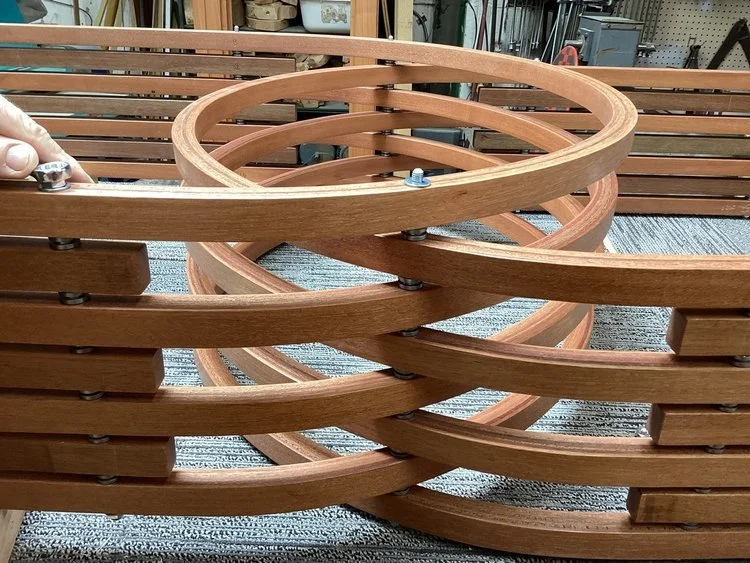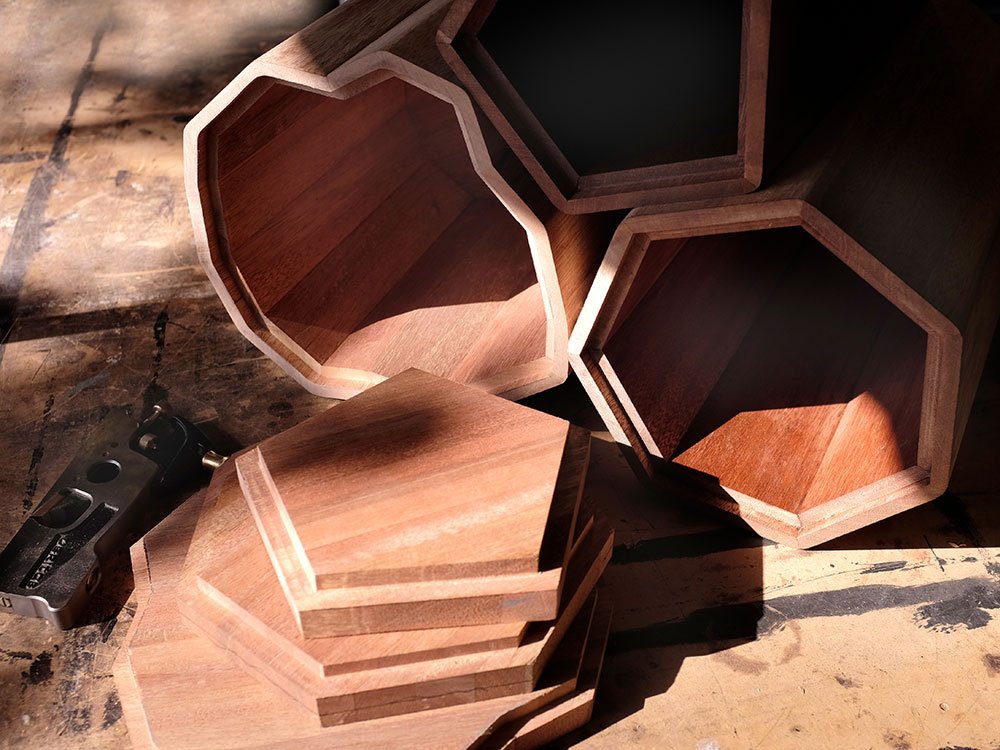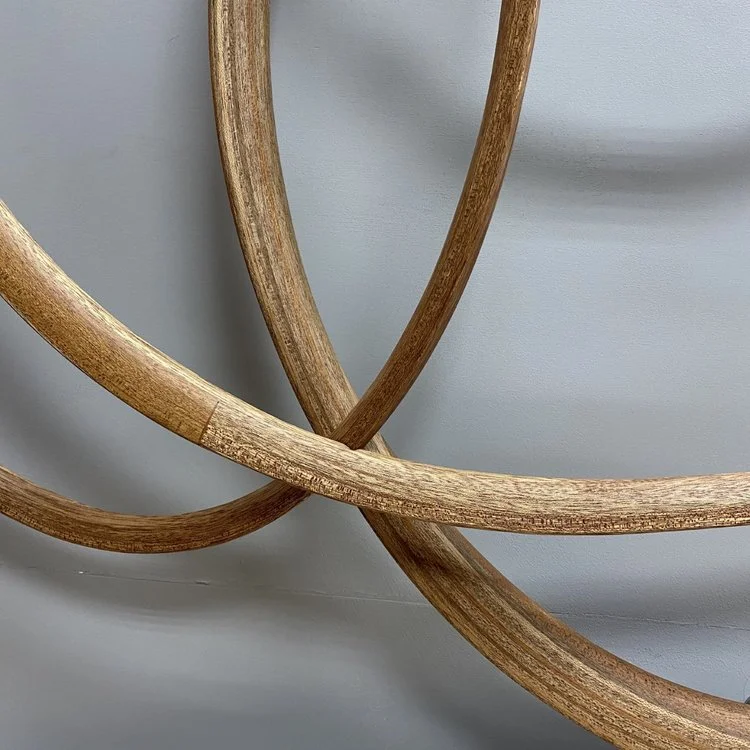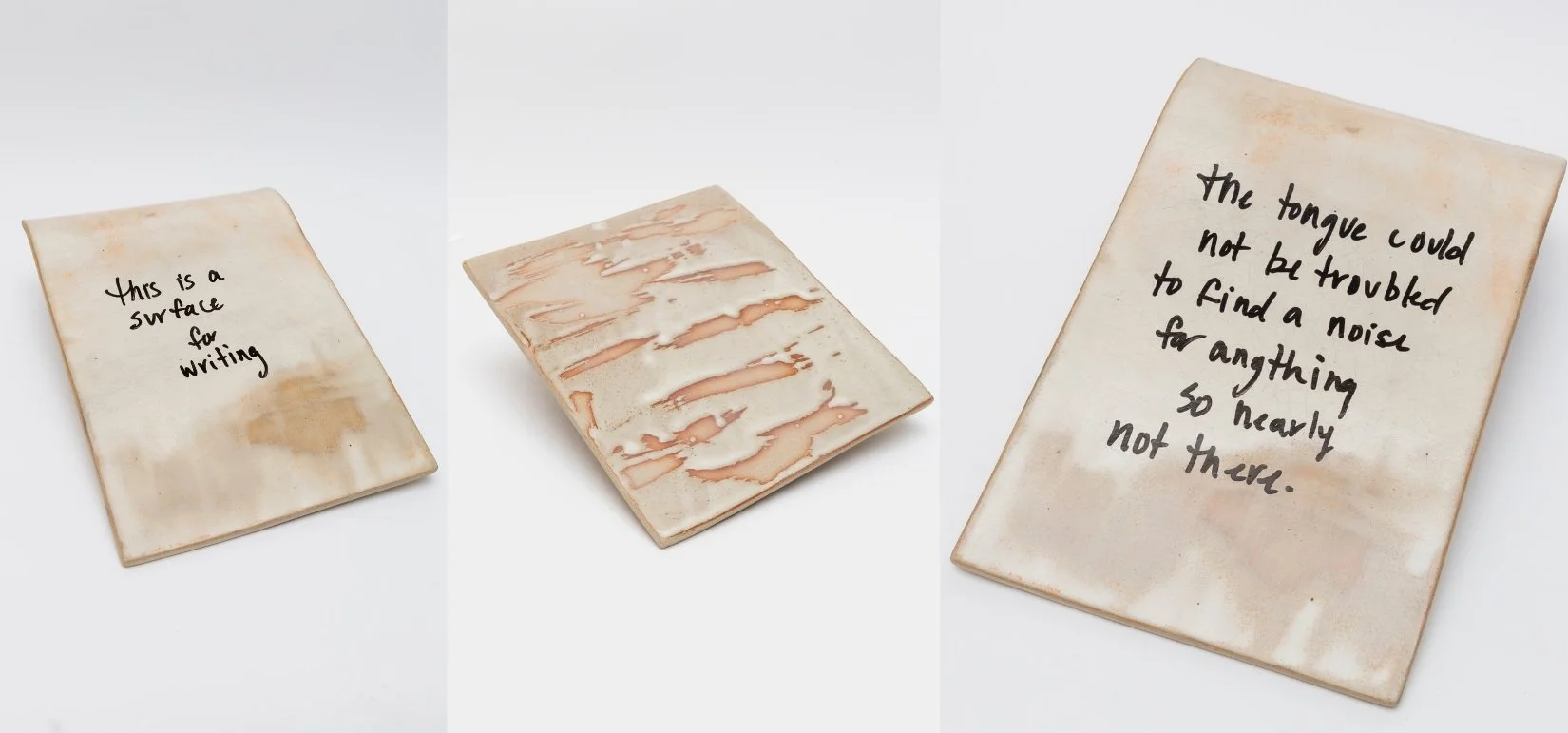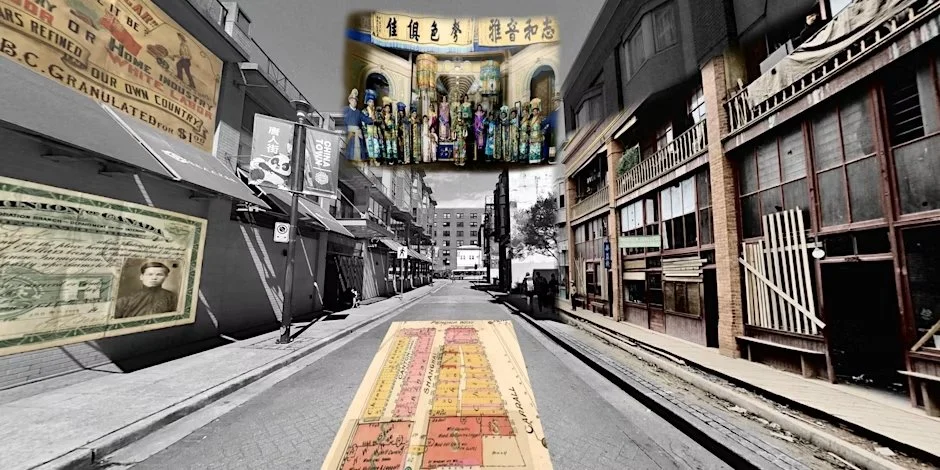Reclaim + Repair: The Mahogany Project finds inspiration in wood that was going to waste, at Museum of Vancouver
Propellor Studio gathers local artisans and designers for an exhibition that spans lighting, a surf board, and a guitar
The intersecting pieces of Arnt Arntzen’s Adrift.
Jordan Lypkie’s Objects if Encounter
Propellor Studio and MOV present Reclaim + Repair: The Mahogany Project at the Museum of Vancouver to August 7, 2024
INSPIRATION COMES IN many forms. Sometimes it emerges from a struggle—be it mental, physical, or metaphysical—and other times it just lands in your lap.
For the local artisans featured in the Museum of Vancouver’s new exhibition, Reclaim + Repair: The Mahogany Project, inspiration arrived in tangible form, embodied in piles of tropical hardwood that had been harvested in the previous century.
Viviane Gosselin, MOV’s director of collections and exhibitions and curator of contemporary culture, tells Stir that the mahogany on view in the exhibition came from a local business that specialized in designing and manufacturing marine equipment. When that company shuttered its factory, the wood went into the care of a cultural organization that kept it in storage for many years.
Recognizing that this material deserved a second life, the organization donated it to the Museum of Vancouver’s upcycling design program. MOV put out a call for submissions last December. From 65 proposals, a committee of designers, architects, and art critics selected 22 projects, and the winning artisans had from late January to June 1 to bring their visions to life using their allotment of the mahogany.
The museum teamed up with local lighting design and sculpture studio Propellor Studio to co-curate the exhibition. (Propellor also created one of the installations featured in the show—a multipiece work that includes a light sculpture called Rivulet, with dangling, 2.5-metre-long LED-illuminated rods of mahogany.)
“We have a long-standing relationship with the Museum of Vancouver,” Propellor Studio designer and principal Toby Barratt tells Stir. “We’ve been designing and curating shows with them for over a decade now. It started with a show about bicycle culture in Vancouver, back in 2009. We have a really great working relationship with them, so when they came into this trove of vintage mahogany, they let us know about it.”
Barratt says the selection committee was mindful of showcasing a diverse range of work. Given the material in question, it would have been all too easy to have an exhibition featuring 22 different variations on mahogany tables or chairs.
Detail of Rivulet by Propellor Design. Photo by Christianzane Media
Closeup of a piece by Brent Comber
Some of B.C.’s most innovative furniture-makers have indeed contributed their talents to the project—including Arnt Arntzen; Josiah Peters and Ryan Tam of Lock and Mortice; and Mario Paredes of Workbench Studio. Others, however, branched out, crafting everything from an acoustic guitar (Shelley D. Park) to a surfboard (Stu Coleman of SDC Woodworks).
One of Barratt’s favourite pieces does involve furniture, but it’s clear that its creators were thinking outside the box—or outside the bench, if you will.
“One project I really like, just for the holistic approach that the designers have taken, is one by Christa Clay and Kevin Isherwood,” Barratt says. “Their studio is called Studio AY, and their project is called Parts of a Whole. They created a beautiful coffee table and stools that go around it, but then from the offcuts of that, they carved spoons, they made wooden bowls and dishes, and they made some beautiful ceramics where they took the sawdust from the mahogany to do a raku fire, and came out with these beautiful mahogany-ash-glazed ceramics. They also made some paper out of mahogany fibre, really showcasing how what would otherwise be considered waste could be turned towards making beautiful additions to their main piece.”
That basic idea of giving life to something that would otherwise go to waste is at the heart of the Mahogany Project. Participants were tasked with making something beautiful out of wood that would never be used for its originally intended purpose. This turned out to be a bigger challenge than anyone anticipated.
“It was generally in good condition, but what we and the other designers discovered was that, from board to board, they were radically different,” Barratt explains. “Some boards were very light in weight and others were dense and super heavy; some boards were very light in colour, almost not even looking like mahogany, because when you think of mahogany, you typically think of a darker, slightly reddish wood, and there was a real range from really dark to really light.”
Some of the boards also bore rust-stained nail holes, a reality with which Barratt says designers grappled in a variety of ways: “Some really celebrated those marks of the history of the material and just put them front and centre; others found interesting ways of kind of repairing those blemishes.”
“We knew that this wood was imperfect, and then people really embraced the flaws,” MOV’s Gosselin says. “I just think it’s very humbling and very inspiring for people. I’m hoping that people will be, like, ‘Okay, what kind of urban mining can I do?’ There’s just so much underused, dormant material out in the city, so I hope other makers will be inspired.”
The wood itself was harvested in Nicaragua and Guatemala between the 1950s and 1970s—an era that saw Central America’s rainforests denuded at an appalling rate. In subsequent decades, the government of Guatemala has made strides towards conservation, but Nicaragua is another, more troubling story altogether.
Nicaragua is home to the Bosawás rainforest, the second-largest in the Western hemisphere after the Amazon. Tragically, it is also the country that has the world’s fastest rate of deforestation—and that rate is actually increasing, especially in the far north and south of the country, where Indigenous communities live.
Gosselin is acutely aware of the troubling provenance of the wood showcased in Reclaim + Repair. “I’m really interested in regenerative ways of working, and it just felt like, if we benefit from this tropical wood, we have to give back,” she says. “We have to take responsibility.”
Barratt echoes this sentiment, saying, “Given that we know that this material was extracted in a period where it was definitely an exploitive extraction process, we and the museum wanted to do something with the wood that would go some distance to address that history and if possible make something beautiful and do some kind of repair to that history.”
All of the works in the exhibition are for sale, and a portion of the proceeds will be donated to support Indigenous-led reforestation efforts in Nicaragua and Guatemala.
If Reclaim + Repair leaves you marvelling at the skill that went into the making of each piece while simultaneously vowing to be more mindful of the ways you acquire and consume the objects in your life, then it has done its job, as far as Barratt is concerned.
“What we’d like people to come away with is, a) what a great community of craftspeople and designers we have in the city, and b) just how committed they are to creating a more sustainable future through their work,” he says.


